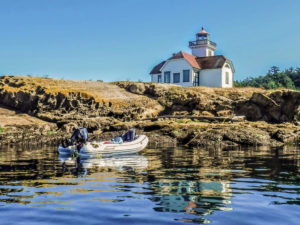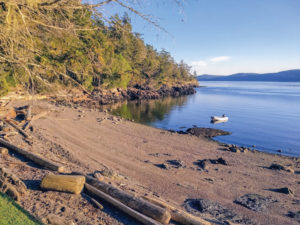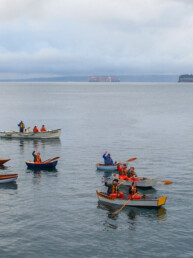This article was originally published in the March 2022 issue of 48° North.
While waiting out winter in Washington, we’re slowly preparing for the upcoming cruising season about our 1980 Monk 36 trawler, Limerick. As I type this, she’s all wrapped up at the storage yard and we are sitting by the fire thinking about how to improve our daily commuter, Shamrock — a 10-foot fiberglass AB Navigo dinghy with 15 hp Tohatsu outboard.
On land, we drive a camper minivan but, like many cruisers, when we are out cruising our “car” is the dinghy, and we use it a lot. Accordingly, we have spent a lot of time optimizing Shamrock for sightseeing, freediving, and fishing adventures; or for trips ashore to hike, have a picnic, enjoy a bonfire, and go shopping in town… you name it.
In the interest of helping other cruisers enhance their dinghy setups for cruising adventures this season, here are some ideas you may want to consider for your own “car”.
DINGHY DEPLOYMENT

Having a dinghy that can be deployed and retrieved quickly and easily from the boat is a key element for most cruisers in the Pacific Northwest and beyond. Shamrock is on a hydraulic lift fitted to Limerick’s swim platform on the transom with the outboard on a swing bracket. The outboard sits upright when the dinghy is secured and rotates into position as the dinghy is lowered.
We can deploy or retrieve the dinghy in less than a minute, which can be handy in a pinch. This proved to be very useful when Limerick’s main engine quit due to clogged fuel filters just outside of an anchorage in Pendrell Sound, BC. Acting quickly, we deployed the dinghy and gave ourselves a tow — another great reason to have a powerful outboard.
For those on sailboats where this hydraulic lift system isn’t possible, dinghy davits on the stern are a popular choice. You just want to make sure the davits can raise the dinghy high enough off the water so that following seas
can’t overwhelm and swamp your beloved tender. These instances are
rare, but they do happen.
The common alternatives to these preferred options are things like hoisting a dinghy upside down on the foredeck or towing it behind the boat using a painter or bridle. Each of these options has their merits in certain circumstances — ocean or extremely rowdy conditions for the dink on the bow and short, flat-water transits for towing. But the downsides are significant (stowing/deployment time and effort with the boat on the bow; and risk of loss, capsize, fouled propeller, etc. when towing) and really make a more permanent and easy-to-use dinghy storage and deployment arrangement optimal.
GOING TO SHORE
After having to heave our dinghy off the beach, swimming out to the dinghy during a high tide, and seeing others struggle with high and dry boats, we went looking for solutions. On our previous boat, Camille, a Hunter 380 that we cruised in Mexico, we had folding dinghy wheels so we could roll the dinghy on and off the beach. That was all well and good, but Shamrock’s outboard is too heavy for that and the beaches here in the Pacific Northwest are often loosely packed and can mostly be composed of rocks or pebbles.
To solve the problem, we found this amazing anchor system to help us land and then retrieve the dinghy from shore. Along with a good anchor and a 100-foot floating line, we can now anchor the dinghy far off the beach and pull it back to shore at almost any stage of the tide.
The Anchor Buddy system is a bungee cord that stretches out 50-feet, but it can be tricky to know how far the dinghy will end up from shore at different depths. It is usually easiest to take the floating line to shore first and row back out to its full length before tossing out the anchor attached to the bungee. It all depends on the tide, the length of your shoreline, and where you think the water level will be when you get back to the dinghy.
NAVIGATING & FISHING

We were using our phones for navigation in the dinghy but we also wanted a sonar to find the good crab and prawn fishing spots. We found a great combo unit from Raymarine, the Dragonfly 5PRO, which has a depth range down to 600 feet, something most portable models can’t achieve. We can even transfer this set-up to the kayak, and combined with a small lithium battery, we can be out fishing all day. The Dragonfly uses the same Navionics charts we use on our phones and tablets, and one of the best features of this unit is that it can transmit depths via WiFi and then plot those to the Navionics charting app on our tablets and phones. It’s great for scouting out a new anchorage or finding that perfect spot to drop the shrimp pot.
THINGS WE KEEP IN OUR DINGHY
◊ Throwable cushion: We have a seat cushion that is also a USCG approved Type IV throwable in case of a crew-overboard situation. Ours is covered in vinyl fabric instead of ripstop nylon, so it doesn’t absorb moisture and we can sit on it after a quick wipe. The vinyl ones are harder to find and a bit more expensive, but are worth it. We always have a microfiber cloth or two on the boat as well.
◊ Life Jackets: We were lucky that Limerick came with six manual inflatable PFDs, and we keep one per person in the dinghy.
◊ Dinghy Ladder: Getting back into a dinghy is not easy even if you went into the water by choice. If you fell in, are cold, and wearing heavy clothes, it can be near impossible, even with a rope ladder. We found a great three-step ladder from Scandia Marine that doesn’t take up much space, is narrow, and works well for our dinghy.
◊ Info Sticker: This convenient sticker has our boat name and phone number on it in case the dinghy drifts away due
to a poorly tied knot or a dragging anchor. We also have stickers on the kayak and paddleboard. You can pick up free ones from many local chandleries around the PNW.

◊ Small Tool Kit: Our kit includes spare parts like spark plugs, fuel filters, and a spare outboard key. (PLEASE always secure your kill switch to your wrist or ankle, we know someone who lost a leg from being run over by a run-away dinghy.)
◊ Nalgene Bottles: These are great in an emergency and can keep small items dry. Ours contains an emergency whistle (required), a small compass, electrical tape, spare batteries, baggies, a small first aid kit, waterproof matches, a flashlight, a Swiss Army knife, pen and waterproof paper, hand warmers, and a space blanket.
◊ Oar Tethers: After losing an oar while towing our previous dinghy behind Camille, we now use 3mm poly-braid to attach the oars to the dinghy.
◊ Communications: Having a way to contact other boats or potentially emergency services is essential, and keeping a working radio aboard is an indispensable part of our kit. We have a waterproof and floating Icom VHF and always bring a cell phone, too.
◊ Drybags: They don’t stay permanently on the dinghy, but we always bring at least one along to hold our phones and dry clothes as needed. I don’t like the heavy, rubbery drybags and instead use the ones made of an ultra-light nylon material.
◊ Cable Lock: Dinghy theft was more of a problem in Mexico but we still try to be vigilant here in the PNW. You never know. We use all Yakima products with the same lock core so we just need one key. The cable lock is nine feet long and covered in rubber so it doesn’t chafe the dinghy.

◊ Instant Patch Kit: There is no use in carrying the patch kit supplied with the dinghy — that takes hours to dry. If you are out and about you need to be able to patch a hole instantly. For a Hypalon dinghy, get Type A. For a PCV boat, get Type B.
◊ High-Volume Air Pump: A K-Pump air pump is small, has no parts that break or rust, and you don’t need a flat surface to use it like with a large foot pump. Best of all, they are made in the Pacific Northwest. Don’t forget a pressure gauge.
◊ Bailing Device: We love our dinghy’s flat interior floor to keep the crew stable. At the back of the dinghy is a depression to collect water, making it super easy to bail the boat and keep the floor clean and dry. It can also hold clams.
We can’t wait to get back out cruising this spring and maybe even back to beautiful British Columbia; and when we do, both Limerick and Shamrock will be ready. We hope this helps you get your dinghy in shape for the upcoming cruising season. If you see us, stop by and say hello. See you on the water!






